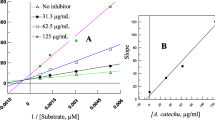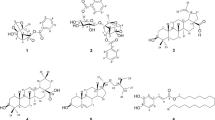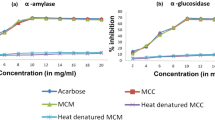Abstract
Three plants namely, Otostegia persica, Salvia mirzayanii and Zataria multiflora are used as antidiabetic agents in the traditional medicine of Hormozgan and Fars provinces, Iran. In this study, the inhibition of α-amylase by the ethanol extracts and fractions of aqueous extracts of these plants was investigated. To measure the enzyme inhibition, 5 and 20 mg/mL of the extracts, and to measure kinetic properties of the enzyme, 5 mg/mL of the extracts, were incubated with 0.5 % of starch (as substrate) and 20 µL of the enzyme. Kinetics studies of α-amylase showed that Km of the enzyme in Otostegia persica and Salvia mirzayanii in comparison with different concentrations of acarbose (0.5, 1 and 2 µM), increased and decreased, respectively. Km of the enzyme in the presence of Zataria multiflora in comparison with 2 µM of acarbose increased and in comparison with the other concentrations of acarbose (0.5 and 1 µM), it decreased. The inhibition of α-amylase by Otostegia persica, Salvia mirzayanii and Zataria multiflora was competitive, mixed and noncompetitive, respectively. The inhibition of α-amylase by acarbose was noncompetitive. Ethanol extracts of Otostegia persica (96.7 ± 1.05 %) and Zataria multiflora (59 ± 6.8 %), and water–methanol fractions of Salvia mirzayanii (94.8 ± 2.5 %) and Zataria multiflora (93.4 ± 2.2 %) had significant inhibitory effects on α-amylase, respectively.








Similar content being viewed by others
References
Afrisham R, Aberomand M, Ghaffari MA, Siahpoosh A, Jamalan M (2015) Inhibitory effect of Heracleum persicum and Ziziphus jujuba on activity of alpha-amylase. J Bot 20(2015):1–8
Bailey CJ, Day C (1989) Traditional plant medicines as treatments for diabetes. Diabetes Care 12:553–564
Bhandari MR, Anurakkun JN, Hong G, Kawabata J (2008) α-Glucosidase and α-amylase inhibitory activities of Nepalese medicinal herb Pakhanbhed (Bergenia ciliata, Haw.). Food Chem 106:247–252
De Oliveira AR, Pereira CA (2015) Inhibition of alpha-amylase by “insulin plant” (Myrcia sphaerocarpa DC) extracts: an alternative for the treatment of diabetes mellitus? J Appl Sci Pharm 5:089–093
Dey L, Attele AS, Yuan CS (2002) Alternative therapies for type 2 diabetes. Altern Med Rev 7:45–58
Fallah H, Fakhr H, Zadeh H, Larigani B, Sheikh Samani AH (2006) Review of anti-diabetic medicinal plant used in traditional medicine. J Med Plants 5:1–8
Franco OL, Rigden L, Melo FR, Grossi desa MF (2002) Plant α-amylase inhibitors and their interaction with insect α-amylases. Structure, function and potential crop protection. Eur J Biochem 3:269397–269412
Frati Munari AC, Benitez PW, Raul Ariza AC, Casarrubias M (1998) Lowering glycemic index of food by acarbose and Plantago psyllium mucilage. Arch Med Res 29:137–1341
Gallagher AM, Flatt PR, Duffy G, Abdel-Wahab YHA (2003) The effects of traditional antidiabetic plant on in vitro glucose diffusion. Nutr Res 23:413–424
Ghahraman A (1996) [Color atlas of Iranian Flora] Persian. Research Institute for Forests and Rangelands Press, Tehran
Gilbert MP, Pratley RE (2009) Efficacy and safety of incretin-based therapies in patients with type 2 diabetes mellitus. Eur J Intern Med 20:S309–S318
Hajhashemi V, Rabbani M, Asghari GR, Karami S (2004) Effects of Otostegia persica (Burm) Boiss on morphin withdrawal syndrome in mice. IJPR 3:171–175
Hasenah A, Houghton PJ, Soumyanath A (2006) α-Amylase inhibitory activity of some Malaysian plants to treat diabetes; with particular reference to Phyllanthus amarus. J Ethnopharm 107:449–455
Khacheba I, Djeridane A, Yousfi M (2014) Twenty traditional Algerian plants used in diabetes therapy as strong inhibitors of α-amylase activity. Int J Carbohydr Chem 2014:1–12
Kurahashi M, Inomata K (1998) Amylase secretion by paratoid glands and pancreas of diabetic rats during feeding. Am J Physiol 254:8782–8788
Larijani F, Zahedi F (2001) Epidemiology of diabetes mellitus in Iran. Iran J Diabetes Metab 1:1–8
Mathers J (2002) Choosing your carbohydrates to prevent diabetes. J Nutr 88:107–108
Mirzaalian Dastjerdi Z, Namjoyan F, Azemi ME (2015) Alpha amylase inhibition activity of some plants extract of Teucrium species. Eur J Biological Sci 7:26–31
Nizam U, Rakib H, Monir H, Arjyabrata S, Nazmul H, Mahmudul I, Motaher HC, Sohel R (2014a) In vitro α-amylase inhibitory activity and in vivo hypoglycemic effect of methanol extract of Citrus macroptera Montr. fruit. Asian Pac J Trop Biomed 4:473–479
Nizam U, Rakib H, Monir H, Arjyabrata S, Nazmul H, Mahmudul I, Motaher HC, Sohel R (2014b) In vitro α-amylase inhibitory activity and in vivo hypoglycemic effect of methanol extract of Citrus macroptera Montr fruit. Asian Pac J Trop Biomed 4:473–479
Shareef MI, Mohan Reddy PJ, Gopinath SM, Dayananda KS, Mandal A, Purushotham KM (2014) In vitro α-amylase inhibitory activity of the leaves of Tinospora cordifolia. Int J Innov Res Sci Eng Technol 3:10091–10096
Sharififar F, Mozaffarian V, Moradkhani S (2007) Comparison of antioxidant and free radical scavenging activities of the essential oils from flowers and fruits of Otostegia persica Boiss. Pak J Biol Sci 10:3895–3899
Van de L, Floris A (2008) Alpha-glucosidase inhibitors in the early treatment of type 2 diabetes. Vasc health risk manages 4:1189
Ziyyat A, Legssyer A, Mekhfi H, Dassouli A, Serhrouchni M, Benjelloun W (1997) Phytotherapy of hypertension and diabetes in oriental Morocco. J Ethnopharmacol 58:45–54
Acknowledgments
The authors thank Hormozgan University of Medical Sciences (Grant No. 9316) and Shiraz University of Medical Sciences (Grant No. 8672) for the grants.
Author information
Authors and Affiliations
Corresponding author
Rights and permissions
About this article
Cite this article
Moein, S., Jahanshai, S., Rahimzadeh, M. et al. Kinetic of α-Amylase and Comparison its Inhibition by Ethanol and Aqueous Extracts of Otostegia persica, Salvia mirzayanii and Zataria multiflora . Iran J Sci Technol Trans Sci 42, 339–345 (2018). https://doi.org/10.1007/s40995-016-0043-6
Received:
Accepted:
Published:
Issue Date:
DOI: https://doi.org/10.1007/s40995-016-0043-6




